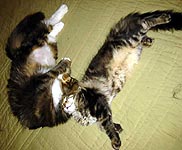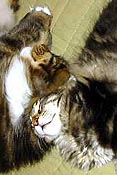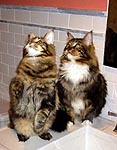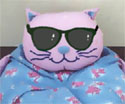Vol. 1, No. 33
Table of Contents
Assist Feeding – Tale of Two Kitties
Feline Nutrition – Miscellany
Pro-Active Cat Care – Does it really make a difference?
Feline Obesity – Stick with the Diet Food
Kitty Potpourri – So Kitty Can’t See!…, Part I
Assist Feeding – Tale of Two Kitties
Jan and Gary VanderPutten
We took our two Maine Coon Cats (Nancy-6 months- and Sluggo-1 year) to the vet on Saturday. She to have her sutures removed from her recent neutering, he for his annual check up and booster shoots. We discovered that like many Coon Cats, Sluggo was developing the telltale red gum line of feline gingivitis, and we were confronted with the possibility of providing regular dental care to a rather large cat (16 lbs) that would only get bigger. We declined the Rabies shot as we lost our last cat to VAS, and our cats live in an apartment.
Back to the point.  On Monday we noticed two vomit patches. By Monday night neither cat was interested in food. Now, these cats normally can eat 3 cans of food a day, plus dry food, if you give in to them, so this new behavior was a concern. We could not detect anything obvious (warm nose, listlessness, lethargy). This was really troubling to us as we had never experienced a non-eating cat.
On Monday we noticed two vomit patches. By Monday night neither cat was interested in food. Now, these cats normally can eat 3 cans of food a day, plus dry food, if you give in to them, so this new behavior was a concern. We could not detect anything obvious (warm nose, listlessness, lethargy). This was really troubling to us as we had never experienced a non-eating cat.
On Tuesday there was no change other than we could get them to eat a treat. More vomit. We Googled our way around the cat forums and message boards – there was lots of data, but nothing conclusive; there were too many reasons for this kind of cat behavior. What was getting clearer was that this could become a serious problem in a few days, especially for Sluggo, a large juvenile cat. By late Tuesday I had tripped over this web site via an e-mail link.
On Wednesday Sluggo nibbled, Nancy did nothing,except displayed no loss of energy. We bought fancy cat food, the kind that looks good enough to put on crackers and serve to your guests. They both seem to drink and pee normally. But we were really spooked – never had this happen before. That night, we received Kathy’s email (a pleasant surprise) that underscored the need to perhaps see a vet.
Thursday – no change, some more vomit. Sluggo would eat about 1/4 of a cup of food a day, including sardines. Our vet is off on Thursday so I leave work early and we find another, and miraculously, we go right in to see him.
Now, Sluggo is not a big fan of vets, and seems to take the thermometer thing a bit too personally, nor does he forget. Kinda tricky getting him outta that carrying case. So he growled a little but did ultimately let the vet examine him, and quickly returned to the safety of his carrier. Low-grade fever, but otherwise in good shape. The fact that he had lost ½ pound in a week didn’t impress the doc. Stool sample was normal.
Nancy was easier to deal with. She also had the same  fever, damp nose, and…. kitty boogers! His concern was that she had not eaten in 3 days. The vet got out some high-end fishy cat food, gave her a shot, lowered the lights (dinner mood lighting?) and she ate about ¼ can.
fever, damp nose, and…. kitty boogers! His concern was that she had not eaten in 3 days. The vet got out some high-end fishy cat food, gave her a shot, lowered the lights (dinner mood lighting?) and she ate about ¼ can.
His prognosis was that they both had an upper respiratory virus, probably got it from the last vet (these things go around quickly), they were probably nearing the end of it, there was little to be done about it but wait for their immune systems to kick in, and that we need to be more aggressive about feeding, especially Nancy. Got some more varied cat food.
Friday – little change, Sluggo advancing faster. More vomit. They do like the Purina in those little cans, even if it is just a nibble. They are still very active. Nancy will eat some dry food, but no wet.
Saturday – More of the same-Gave Nancy some of that drug with my newly purchased pill inserter. She slept all day.
Sunday – Awoke to Sluggo’s meowing – his typical 5 am routine-only this time he ate the food in his more normal way, he scooped it out with his paws and then ate it. Nancy ate a little of the wet. By nighttime she started eating here dry food, about ¼ cup.
Monday – They both are eating more normally but we are giving them only small portions. Normal litter box behavior is returning.
Tuesday – Back to normal. They had rejected all other cat foods but their original boring Science Diet selection-go figure. What a relief. Now it’s back to training the humans to provide a more modest diet.
rejected all other cat foods but their original boring Science Diet selection-go figure. What a relief. Now it’s back to training the humans to provide a more modest diet.
Feline Nutrition – Miscellany
by Garry White
Along the way, I’ve gathered a mix-mosh of tips and hints regarding the feeding our furry friends, and I thought I’d share some of them with you this week. And by the way, please feel free to pass along to us your own tips, Hmmm? Kathy at AssistFeed.com
- Contrary to old beliefs, feeding milk (or other dairy products) to a cat is not a good thing. Many cats (most, actually), cannot process the lactose, with the common result being digestive upset and diarrhea.
- Canned foods should be served at room temperature. Microwaving is a no-no in this household, for two reasons: Microwaves can (and do) destroy natural enzymes. Two, the food can get “hot-spots”, and cats will avoid anything that doesn’t appear natural. Of course, canned food spoils quickly, so we’re forced to refrigerate opened cans. Tip: From the Fridge, mix it with a couple tablespoons of hot tap-water to get close to a “natural” temperature.
- Don’t believe that dry food lasts forever.it doesn’t! I think you know that Kathy and I are now feeding our gangs a holistic food, and I gained a very good tip from the manufacturer: Keep the food –BAG AND ALL– inside a sealed container. Reason being, is that the BAG is specially treated (inside) to extend the shelf-life of the food. Hmmm! I called three other manufacturers, and two of them said the same thing (the third one suggested keeping the food on a GLASS container with an airtight lid.
- Table scraps in very small doses are okay as an occasional ‘treat’, but not as a diet. Things to avoid: Too much fish cooked for humans (not enough vitamin-E), chocolate (toxic to kitties!), garlic, onions, anything with caffeine, corn (they cannot digest it properly), sweets, mushrooms. NO BONES! Some may challenge this, but feel free.the fact is, an undigested bone can easily end up as a perforated colon, and there’s no benefit that could possibly offset such a risk.
- Don’t force (or try to reason with) a finicky eater: Offer them something different.
- Another untrue myth: If a cat gets hungry enough, it will eat whatever is on the plate. Not so. A cat will actually starve to death before it will eat something it doesn’t find appealing.
- A kitten’s daily diet should contain between 35% and 50% protein.
- Assure that your cat’s diet is low in magnesium!
- The pros say feed your cat at the same time and in the same place every day.
- Cat feeding habits are attributed to: (a) The cat’s personality, and (b) What we teach them.
- Raw liver can cause a vitamin-A toxicity.
- Raw eggs can cause a deficiency of the vitamin “biotin”.
- If a cat is being fed a diet designed to manage the urinary tract, the food must be made available throughout the day.
As always, we encourage you to give us your own hints and tips that have proven to be successful.
ProActive Cat Care – Does it really make a difference?
by Garry White
If you were to guess at how many of us take seriously the concept of proactive care for our kitties, what would your answer be? Many? Most? A few? My own guess would be that most of us do, at least to a degree. We could do more, certainly, and that’s what this article is all about: doing more. I make this point for reference only: How many times have we seen those graphic posters in the vet’s office that how an untreated animal bite can fester, or perhaps the ones that show the damage fleas can do? And how many times do we actually stop and read them? Don’t get me wrong.I’m betting that every one of us does ask the vet about a proper diet, maybe some kind of dental care, should Fluffy be allowed to have or do this or that. But it’s not enough, and the timing is wrong. Imagine that you’re already late for work, and I’d like to talk to you about estate planning. Your response would be something like: “Look, Bub; some other time, huh?” And rightly so; my topic was worthy enough, but my timing was wrong. However, we do want to chat with the vet when he/she isn’t racing to the next patient, and I know two things from experience: One, vets do love to chat about their profession. Two, vets love a free lunch as much as anyone. Be honest, tell them your goals, and give it a try.
In response to the question: Does proactive care really make a significant difference? We all know that some beings (human and animal) do not live past infancy, while others commit every biological sin possible and live to a ripe, old age. So it would seem that there’s no clear-cut answer to this, but don’t believe it. What I just mentioned are exceptions, not the norm. We cannot prevent exceptions from happening, but we’ve learned enough about biological systems to know that the real answer is.YES! Proactive care does make a huge difference, and can extend the life of a cat not just a few months or years, but many years!
Perhaps some of us see a good proactive-care program as overwhelming, and indeed it can have many tentacles. But here’s a good tip: Don’t try to see the whole forest at once. Don’t flood yourself with the many things you should be monitoring and maintaining. Take them one at a time, and develop your proactive-care program. Trust me, it will become routine. I’ve always had the philosophy that there’s no such thing as a dollar; it’s a hundred pennies. Think in terms of “pennies” with your program, and pretty soon Fluffy will be worth a whole dollar!
And don’t forget to take that vet to lunch!
Feline Obesity – Stick with the Diet Food
by Kathy Fatheree
Have you ever been on a diet and you are doing really good, but then you blow it one day. perhaps you go out to lunch with friends or co-workers and they choose, let’s say. Mexican food! Oh! And who can resist the power of cheese? (Is that the slogan I identify with?) You order cheese enchiladas. Well, there went the diet for today! And boy did it ever taste good! Then that night at dinnertime you are still remembering the savory sensations and you don’t exactly eat a “diet dinner.” The next day you are bound and determined to get back on your diet. BUT you remember the satisfying feeling of eating those fatty foods… those delicious comfort foods! It’s going to be difficult getting on that diet again.
The reason that I bring this all too familiar topic up is because of a situation that I’m dealing with right now with my fat cat Phoebe. Phoebe has been doing fabulous on her diet. she now weighs 18.4 pounds. down from 20.2 at her highest weight. The only problem is that she is dropping TOO fast these last two weeks. Cats should only lose ½ pound per month; any faster than that and the disease Feline Hepatic Lipidosis (FHL) becomes a real risk. Fearing that Phoebe might be at risk, I decided to allow her to eat a few pieces of Maya’s food at every meal. Maya is my skinny kitty and she eats a high-protein, high-fat food. completely yummy! Well .Phoebe has decided that Maya’s food is SO VERY DELICIOUS that it’s worth fasting for. Yep. you heard me right. Phoebe has decided that she will forgo her previously satisfactory food in hopes that she will receive at her next meal. Maya’s muy delicioso food. Maya’s very delicious food.
I sure messed up a good thing! I’m having to back pedal now to get Phoebe back to eating her diet food. I’ve been trying several different things…
Phoebe’s diet food is dry food and here’s what I’ve been doing:
- I sit down on the floor with her and feed her one piece at a time,
- I dip each piece of her into water before she eats it off of my finger,
- I praise her each time she eats a piece of food,
- I feed her only at meal-time, and
- I have stopped giving Phoebe any of Maya’s food and it’s 100% back to the diet food.
Are we back to normal diet-mode yet? No. We are still having a small revolt, but I know she is getting enough to eat to fight off any inclinations of getting FHL. Hopefully things will be back to normal soon.
So my advice to any kitty on a diet. Stick to the diet food and just add more if you are losing too fast!
Kitty Potpourri – So Kitty Can’t See!…, Part I
by Dan Malenski
This week, and the next, we will revisit our discussion on special need kitties and focus on those who are blind or severely visually impaired. At risk of invoking the  wrath of the “thought police”, we will use the term blind to describe the condition instead of the wordier visually challenged. We do hope that no one chooses to turn us in! We will first briefly discuss some of the medical conditions that can result in blindness; we will then move on to how you can gauge your kitty’s ability to see. Finally, in Part II of this article next week, we will outline what you must do as the kitty’s companion in order to insure a comfortable and safe environment. Although a kitty that is blind falls into the special needs category, this does not mean that it cannot lead a full and rich life as any other. As usual, this article (and the next) was a team effort using various sources from the internet.
wrath of the “thought police”, we will use the term blind to describe the condition instead of the wordier visually challenged. We do hope that no one chooses to turn us in! We will first briefly discuss some of the medical conditions that can result in blindness; we will then move on to how you can gauge your kitty’s ability to see. Finally, in Part II of this article next week, we will outline what you must do as the kitty’s companion in order to insure a comfortable and safe environment. Although a kitty that is blind falls into the special needs category, this does not mean that it cannot lead a full and rich life as any other. As usual, this article (and the next) was a team effort using various sources from the internet.
There are multitudes of medical conditions that may result in blindness, and we will cover some of the more common ones here and do our best to summarize. They will generally fall within the two broad categories of injury and disease. Some of them are:
- Injury to the eyeball itself, surrounding tissue, or head that leads to damage to the optic nerve. This includes damage by toxic substances also.
- The most common is inflammation of the membrane that lines the eyelids and covers the eyeball (the conjunctiva), typically caused by a viral infection. Many cats recover without losing their sight.
- Diseases of the cornea are also not rare, which include abrasions caused by catfights and those by infections.
- Others less common are cataracts and cancer, originating either from the eyeball itself or from surrounding tissue.
- Finally, blindness may result indirectly from another disease such as Chronic Renal Failure (CRF), which could raise the blood pressure to abnormal levels. The high blood pressure leads to retinal detachment that causes blindness. This is one cause of blindness that may be reversed if the blood pressure is reduced to normal levels.
Blindness that occurs gradually is more difficult to detect than sudden blindness, but in either case, a veterinarian must examine the cat as soon as possible, because the loss of sight may be due to an underlying condition which may be life threatening. If sight loss occurs suddenly, the signs will be obvious in the form of unusual behaviors such as eliminating in inappropriate places because kitty cannot find the litter box, appears disoriented, hesitates when walking, and frequently bumps into things.
If you suspect that your cat is having vision problems, a good basic test is merely to cover each eye in turn and see if the other is able to follow a moving finger or if it responds to a finger moving toward it. At this time, one of the girls (Amanda) chimed in that a moving finger is a better test than using a light source, because with a light, a kitty may merely be responding to the light and not be able to see the finger (i.e. distiguish shape).
A cat that is blind in one eye may have some problems at the onset of the blindness, but they typically will quickly compensate and need no special care.
Next week, we will list the many things that you must do as kitty’s guardian to insure comfort and safety, and is based upon the assumption of total blindness.
Disclaimer: Kathy Fatheree is not at all a medical expert. Contents of this web site are a collection of Kathy’s assist feeding experiences as well as the experiences of other cat owners who have assist fed their cats. While every effort has been made to ensure the accuracy of the information, Kathy Fatheree or anyone associated with this web site cannot be held responsible for anything that may happen as a result of using the information on this site.
